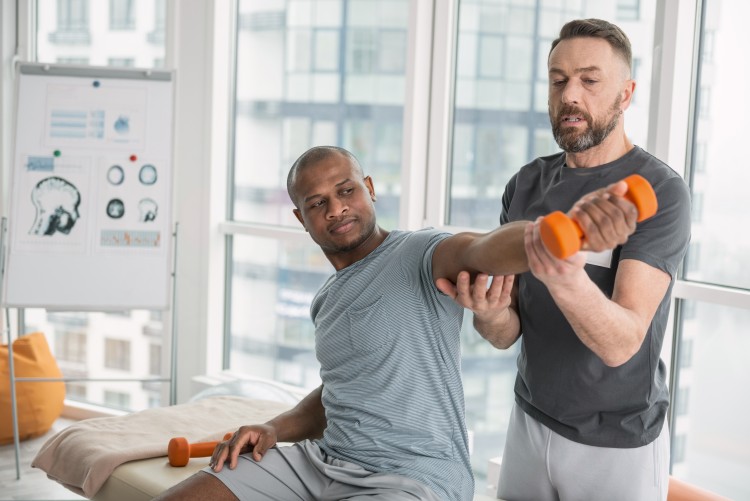What Is Human Performance?

Human performance is a measure of what people can achieve with their bodies. It refers to physical and mental readiness to tackle challenges. Exercise science teaches future trainers, health educators, wellness managers, and physiologists how to assess and improve human performance.
Earning a degree such as an online Bachelor of Science in Exercise Science can prepare students for a career helping athletes, students, patients, and others achieve their potential in human performance.

Components of Human Performance
What is human performance? Answering this question can start with considering who uses the concept and why. Different domains have different reasons for measuring and promoting human performance. Within the field of sports alone, these variations are clear: Basketball, soccer, and swimming place more emphasis on endurance, while racing and gymnastics may require more speed and agility.
Human performance is relevant in a range of settings that include:
- Sports and athletics. Physical achievement is an integral part of sports competitions and entertainment. Athletes have an interest in pushing their bodies to perform optimally — without risking their health in the process. Coaches and kinesiologists help athletes train safely to reach the best results.
- Fitness. Fitness is a growing industry, with more people joining gyms and health clubs as awareness spreads about physical activity’s beneficial health effects. Trainers help educate the public about the best ways to improve human performance and health.
- Education. Staying active and improving performance are important at any age. For example, fitness professionals and educators may encourage exercise and good nutrition for college students, who have specific needs to cope with the challenges of intense schedules and hard work.
- Recreation. This may be the age of smartphone entertainment, but people still take joy in moving their bodies. Recognizing that an active lifestyle is integral to well-being, corporations and universities sometimes hire coaches for their employees or students. Outside of work, trainers and coaches teach the public to stay in good shape through leisure activities.
- Rehabilitation. One key way exercise scientists can improve people’s lives is through rehabilitation after injury. With an understanding of what human performance is based on and how to cultivate it effectively, physical therapists can help patients safely regain mobility and strength.
- Defense. Military personnel must be ready to cope with extreme conditions. Exercise scientists can help soldiers and marines prepare for — and recover from — the challenges of defense, as well as evaluating recruits.
Improving Human Performance
How can trainers and other fitness professionals help their clients improve their performance? It’s not only a question of exercise; diet and lifestyle are also essential factors.
Nutrition
Macronutrients — carbohydrates, proteins, and fats — supply the body with calories for fuel. Athletes eat specific amounts of macros to reach their fitness goals. According to Triathlete, athletes should scale their intake of carbohydrates and protein to their body mass and the number of hours they train per day.
Rest
Sleep and rest are vital to performance. The Centers for Disease Control and Prevention recommends that adults ages 18 to 60 get seven or more hours of sleep per night. Lack of sleep can lead to various health disorders that impede performance.
Equally important, athletes must schedule recovery days between workouts to let their muscles heal. Too much exercise can raise cortisol levels, keeping the body stressed. This can lead to health problems like high blood pressure, high blood sugar, and a weakened immune system, as well as injured muscles.
Hydration
Athletes should be sure to drink enough water or other hydrating, low- or no-calorie fluids. Dehydration can cause confusion, overheating, and mood changes, as well as constipation and kidney stones. Physically active people need more hydration than sedentary people.
Workout Variety
Trainers recommend varying workout schedules for many reasons: to identify hidden weaknesses, break bad habits built up in usual exercises, master whole ranges of movement, and more. Varying workout routines also lets strained muscle groups rest while others work.
How to Track Human Performance
With an idea of what human performance is, how do trainers and other exercise professionals track it? One method is the use of benchmark workouts. For example, a trainer might time a client’s mile run, record the result, and compare this initial time against subsequent runs to track improved speed.
Trainers can also use physical tests to monitor performance, like periodically checking respiratory rates (the number of breaths taken per minute) after workouts or tracking resting heart rate. Resting heart rate is a good indicator of fitness: Generally, lower rates correlate with good levels of fitness.
What Is a Human Performance Lab?
Exercise scientists sometimes use specialized equipment to aid them in evaluating clients’ needs and the course of their improvement. This equipment is what human performance labs specialize in. Maryville University’s Human Performance Lab, for example, has a variety of tools for assessing performance. Exercise science students learn to use these tools when helping athletes and other clients build their capabilities.
Maryville exercise science students can become familiar with a range of technologies through the lab:
- Body composition testing apparatuses. These include calipers or the bioelectrical impedance machine, which measures the body’s resistance to an electrical current and uses the result to calculate ratios of fat to muscle.
- The Vertec system and Hawkin Dynamics force plates. The Vertec system is a steel frame mounted with vanes that mark an athlete’s reach while standing, then jumping. This allows students to calculate the athlete’s vertical jump. A more high-tech option for this type of assessment, the Hawkin Dynamics force plates, measure vertical force.
- The dual-beam laser timing and Ledsreact systems. To test speed and agility, students can use the dual-beam laser timing system, which detects when an athlete’s body interrupts two laser beams and gives a highly accurate time. Another choice for testing speed and agility is the Ledsreact system, which uses radar. These instruments can help exercise students grasp concepts like acceleration and maximum velocity when developing athletic training programs.
- The GymAware and Perch systems. For velocity-based training, the GymAware system measures weightlifting speed using tethers, while the Perch system achieves the same thing with cameras.
- The Wattbike system. The Human Performance Lab also possesses a Wattbike system for assessing anaerobic power (a person’s maximum energy output) and aerobics (efficiency in moving oxygen around the body). For metabolic testing, students can use the VO2 Master on a Wattbike or in the field.
Launch Your Career in Human Performance with an Exercise Science Degree
Maryville University’s online Bachelor of Science in Exercise Science gets students ready for careers in the many industries where human performance matters. Discover how to prepare for a profession in coaching, training, physical therapy, and more with Maryville’s state-of-the-art program. Your skills can help individuals, teams, and organizations thrive.
Recommended Reading
Types of Coaching Styles for Athletes
Psychology of Exercise: Improvements in Mental Health
Growth of Virtual Exercise: The Fitness Industry After Coronavirus
Sources
Advanced Human Performance, “Athletic Performance”
Advanced Human Performance, “A Case for Exercise Variety: 21 Reasons”
Centers for Disease Control and Prevention, “How Much Sleep Do I Need?”
Centers for Disease Control and Prevention, “Water and Healthier Drinks”
Fitness19, “Reasons Why You Should Vary Your Workout Every Day”
JumpStart by WebMD, “What to Know About Rest Day Workouts”
Nike, “What Are Benchmark Workouts — And How Do You Use Them?”
Triathlete, “What Is the Right Balance of Carbs, Fat, and Protein?”

